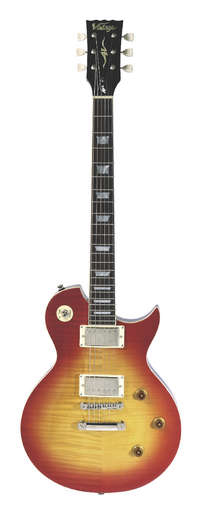MusicRadar Verdict
The AV1 is a fine update on the Les Paul 'single-cut' design - it's very versatile.
Pros
- +
Upper fret access. Versatile sounds. Build quality.
Cons
- -
Weight. Headstock shape. It still draws too much on the Les Paul.
MusicRadar's got your back
Vintage has carved quite a market in the UK, and overseas, for its range of knock-offs, replicas, copies - call 'em what you will.
Leading guitar designer Trev Wilkinson has been working with the brand for the past couple of years and we've not only seen the quality and specification rise but Wilkinson has also enlivened the range with, for example, the Icon range of affordable aged replicas.
But with the launch of the Advance series, copy cloning is put on the back burner in favour of some more original designs like this guitar on test here.
Overview
It's pretty obvious where the design inspiration for the AV1 comes from, and also pretty obvious that even a blind man could tell the difference between this and, of course, the Les Paul.
The slight cutaway on the bass-side of the guitar along with the more pointed horn - part of an agreement that JHS has with Gibson, we understand - seem quite small changes but, boy, they alter the iconic shape, not to mention the upper fret access, dramatically.
Yet shape aside the AV1 still draws heavily on the Les Paul's legacy. The weight is substantial at 10.5lbs but, that aside, it's very tidily made.
There's an added ribcage contour on the back, tidy top binding, a lightly figured top that is very seventies, like the deliciously evocative cherry red 'burst.
The neck too has a full 'C' profile that's not over large and very comfortable, the frets sit over the binding for full playing width and it's all really very neat, as are the crown inlays.
The hardware, pickups (based on PAF spec's given to Wilkinson by original designer Seth Lover), controls and toggle switch all look the part: but do we really need that switch collar?
It's silly things like this that actually prevent the AV1 from being its own guitar rather than a clone of the Les Paul with a court-evading shape.
Likewise the headstock: it's the right thickness, with suitably vintage-y and smooth-actioned tuners (with cream buttons rather than the snot green we're used to) but the shape, because it apes Gibson and can't copy it, looks rather ungainly.
A bit more originality here, a bit more class, would dramatically improve the vibe. But there are some neat ideas within the control layout.
Along with master volume and tone, the third lower control, is called a 'roll control'. When turned fully clockwise it voices the pickups in standard humbucking mode and at the other extreme splits them simultaneously to voice the screw coils of both humbuckers.
It's not a new idea - Peavey, for example, used it back in the seventies - but it works very well. The output jack is neat too: a recessed dished metal 'collar' held with two screws.
The chassis jack screws into this collar so there's no protruding nut - so long as it's securely screwed in it's an extremely smart design.
Sounds
The first thing you notice here is the easily accessible fingerboard and the slightly 'longer' feel to the neck. Oh, and the weight. Sound-wise though, you're in for a treat.
Not quite as awesomely dark as a pucker Les Paul, this is a bit more Deluxe than Standard. But the sound is good, a little brighter and lighter but that allows some wonderful bell-like tones and an old-school snap.
The roll control is inspired, allowing quick single-coil and generally thinner tones - a little too bright fully split on the bridge pickup but with a little volume reduction, which rounds out the highs, and with both pickups on it's a funkier sound.
In fact, Vintage needs to realise this isn't a Les Paul clone - it's a guitar in its own right. A Les Paul lite with jangle-a-plenty. If only it were lighter…
Dave Burrluck is one of the world’s most experienced guitar journalists, who started writing back in the '80s for International Musician and Recording World, co-founded The Guitar Magazine and has been the Gear Reviews Editor of Guitarist magazine for the past two decades. Along the way, Dave has been the sole author of The PRS Guitar Book and The Player's Guide to Guitar Maintenance as well as contributing to numerous other books on the electric guitar. Dave is an active gigging and recording musician and still finds time to make, repair and mod guitars, not least for Guitarist’s The Mod Squad.

“Almost a lifetime ago, a few Burnage lads got together and created something special. Something that time can’t out date”: Original Oasis drummer Tony McCarroll pens a wistful message out to his old bandmates

“A high-quality solution for capturing your drums”: Sennheiser MD 421 Kompakt review

“I need to build a sound of my own that has the power that I want”: Floating Points hates festival sound systems so much that he’s invented his own










